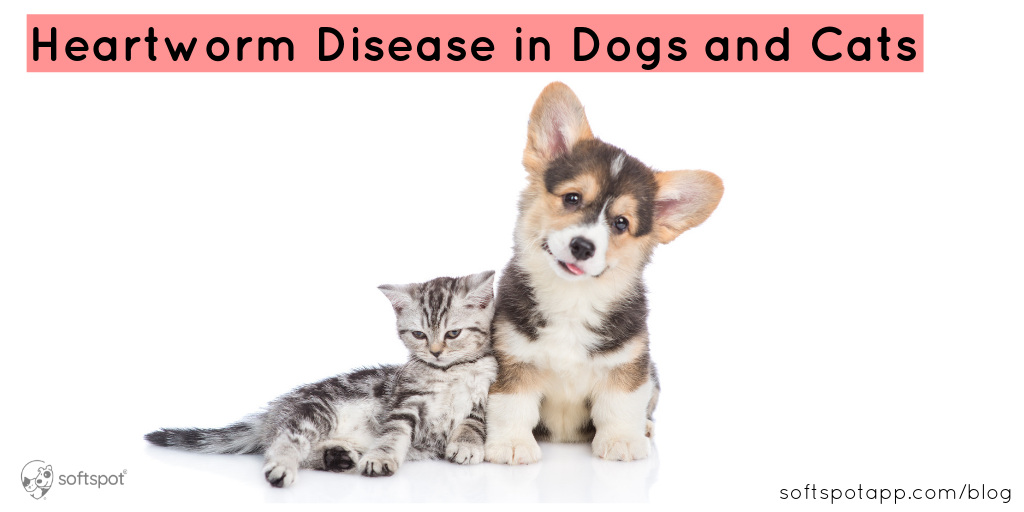What Is Heartworm Disease?
Heartworm disease is a parasitic infection in which worms dwell within the pulmonary arteries of animals. The worms are carried by mosquitoes, who pick up immature larvae by biting one infected animal, then transfer it to another.
Heartworms can grow up to 14 inches long within their host. This causes the arteries to begin clogging, leads to further inflammation, and forces the heart to pump harder, since blood has to make its way around the obstruction.
This condition can affect both dogs and cats, and while it can be difficult to treat, it’s very easy to prevent with heartworm preventative medications. Further, the situation can become more severe for cats, since their bodies tend to be much smaller, compared to dogs. Even indoors-only cats are recommended to receive preventative medications, as mosquitos can easily make their way inside.
Pets with compromised immune systems, as well as those living in humid climates, are most susceptible to infection. If left untreated, heartworms will continue to clog the heart and / or arteries and cause inflammation, which will eventually lead to death.
What Causes Heartworm Disease?
The development of heartworm disease is actually fairly complicated. First, a mosquito must bite an infected animal, filling with blood that contains larval heartworms, called microfilariae.
The microfilariae reach the next step of maturity within the mosquito, and when the bug bites another dog or cat, it also deposits a droplet of saliva next to the site that contains the immature larva. Humid environmental conditions are ideal for the spread of heartworms because this prevents the evaporation of the saliva, and the larvae are able to swim into the bite and remain within the skin layer. (This is why places with humid or warmer climates tend to have higher incidences of heartworm disease, such as Florida.)
After maturing for another three to four months, the worms head into the bloodstream, making their way to the arteries, where they’ll reproduce more microfilariae for another five to seven months. However, the offspring will not mature within the host; they must be passed through a mosquito in order to reach the next stage of growth (and then deposited onto another animal to reach maturity). Microfilariae can live for up to two years within the animal, but if they are not picked up by a mosquito, they will eventually die.
What Are The Symptoms Of Heartworm Disease?
- In its early stages, there are often no symptoms of heartworm. This is why it’s so important to get your dog or cat tested at their annual veterinary exam.
- Coughing
- Fever
- Nosebleeds
- Difficulty breathing or excessive panting
- Lethargy, exercise intolerance
- Anemia
- Dark urine
- Shock
- Heart failure
- Eventual death
How Is Heartworm Disease Diagnosed?
Heartworm disease can be confirmed by a blood test that detects microfilariae or adult worm proteins. The tricky part about this is in the timing; newly infected pets will yield negative tests, as it takes five to seven months for worms to fully mature and start reproducing.
How Is Heartworm Disease Treated?
This condition is tricky to treat and will depend on the health of the animal, as well as the severity of the case. First, the patient must be evaluated to determine the stage of the infestation (from one to four, four being the most severe). Additionally, the veterinarian will determine what types of worms within the body, from young larvae, to fully-grown adult worms, to subsequent microfilariae from mating worms. Immature worms can be killed with oral medications, which may require a regimen that’s several months long. Antibiotics may also be given in order to kill off secondary organisms.
If the patient has fully-grown heartworms, they may require a two- or three- dose treatment involving an intramuscular injection in the hindquarters (the specific medication used will depend on the case). Unfortunately, the shot, as well as the medication, can be very painful for pets and can cause abscesses at the sites. They may be given pain medications to keep them comfortable, and discomfort can last several weeks.
In severe cases, grown heartworms may even need to be surgically removed in order to unclog the arteries, with a medication protocol to follow.
Of course, the easiest way to protect pets from heartworms is prevention. Most preventatives come in monthly doses, and work by killing the larvae before they mature and can begin to cause dangerous symptoms. Further, your pet should be given a heartworm test at their annual veterinary exam, which gives you the best chance at catching heartworm disease in its earliest stages.

